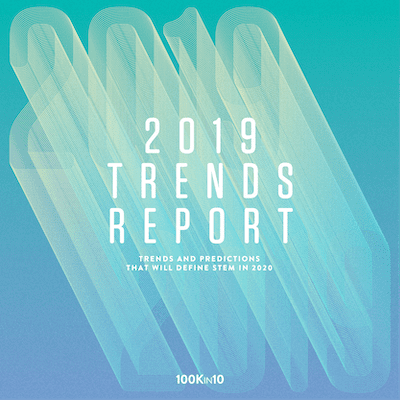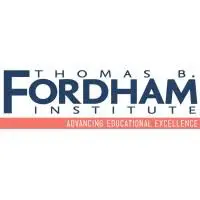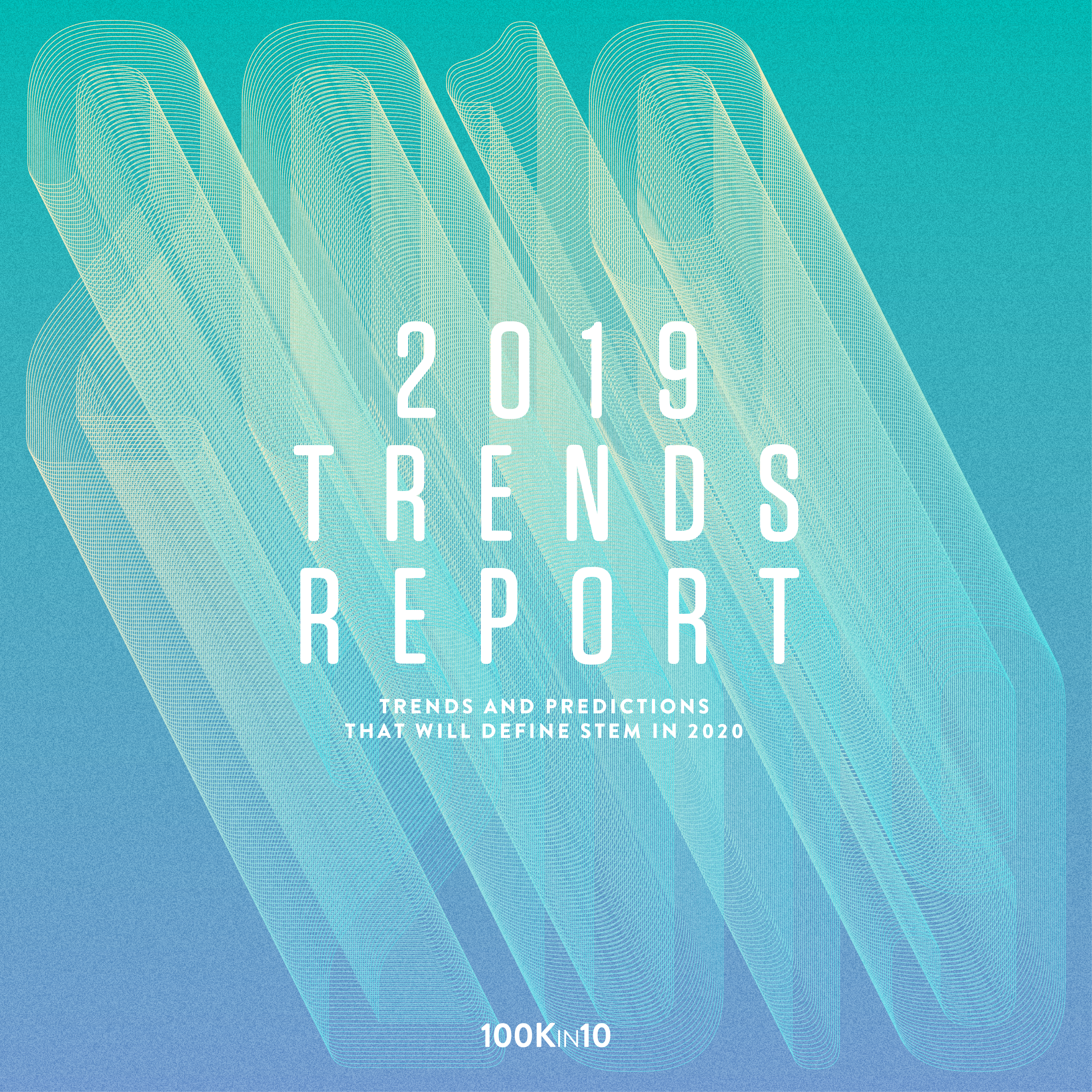
For the past eight years, we’ve made it our mission to grow the next generation of innovators and problem solvers by getting 100,000 excellent STEM teachers into classrooms nationwide. Each year we spend countless hours talking to our partners and teachers, who are the nation’s leaders in STEM education, and poring over research, news, national and regional data, and everything else we can get our hands on. We sift through it to understand what challenges and opportunities are rising to the top, so our network can better address the nation’s STEM teacher shortage.
At the end of each year, we distill our most valuable insights into bite-size chunks and share them in our annual Trends Report. Below you’ll find a mix of trends from 2019 and look-aheads for 2020, each with actionable exemplars from organizations around the country. We know that it’s only through working together, sharing everything we know, and pooling our collective expertise that we’ll ultimately be able to end the nation’s STEM teacher shortage – which is why we are constantly trying to help more of us tap into the collective wisdom of our tribe. We hope you’ll find these insights useful, and we hope you’ll share them, add to them, and most importantly use them as you contribute your uniqueness to our shared goal of 100,000 excellent STEM teachers by 2021.

This year, we’ve been inspired to see growing attention to a body of research that explores the role teachers play in supporting students of color specifically. As The New York Times recently reported, research shows that students of color perform better and achieve greater long-term success when they have at least one teacher of color,” which research suggests is a contributor to the persistent race gap in student achievement. Yet our country is still struggling to meet the need for teacher diversity; people of color represent 50% of students in the U.S., but less than 20% of teachers. At 100Kin10, the message is clear; to increase student engagement and success in STEM, students of color need to see STEM teachers who look like them.

We’ve been inspired by 100Kin10 partners creating new resources, strategies, and programs aimed at advancing racial equity in STEM education. A 2019 Project Team led by the Massachusetts Department of Higher Education and five other partners focused on researching, synthesizing, and sharing best practices and strategies to increase the diversity of the STEM teacher workforce, while a 2020 project team led by Trellis Education will critically examine school structures that are harmful to teachers of color and create a toolkit for school members to support culturally responsive changes in their school environment. Partners like Rowan University, The National Center for Teacher Residencies, and the Kansas City Teacher Residency, and Urban Teachers are also getting involved, working on increasing STEM teacher diversity by partnering directly with Black and Latinx organizations on recruitment pipelines and developing new recruiting strategies for racial, cultural, ethnic, linguistic and socio-economic diversity. We’ve also seen funders, like the Walton Family Foundation, the Ballmer Group, and NewSchools Venture Fund, supporting efforts to diversify the PreK-12 teaching profession.

We’ve known for some time that teachers are the most important in-school predictor of students success, and we’ve also known that, because principals hire and influence a whole school of teachers, they are the second most important factor in student success and the key determinant in creating school environments where teachers thrive. While 100Kin10 is a network focused on teachers, we’re seeing a trend around initiatives focused on building the capacity of school leaders to better support and empower teachers. Improving school leadership appropriately ranks high on the list of education priorities, and 100Kin10 partners are pioneering research, frameworks, and tools to help school leaders foster positive school cultures where teachers feel respected, included, and supported.

In 2019, a project team led by the Council of Chief State School Officers and the American Institutes for Research explored how to measure and strengthen positive work environments in schools, leading to a set of recommendations for leaders to utilize school data to strengthen positive work environments for STEM teachers. In a similar vein, New Leaders developed a Transformational Leadership Framework that distills the actions high-performing principals take to build school structures, systems, and practices that promote teacher effectiveness and accelerate student achievement. Building on this work, a 2020 project team led by California Academy of Sciences and STEM teachers from Northeast Ohio will create a series of case studies that highlight how schools from around the country have successfully built positive work environments for STEM teachers. Meanwhile, partners like The Colorado Education Initiative, Education Pioneers, and The Urban Schools Human Capital Academy are developing initiatives and programs to train future school leaders and grow the capacity of existing principals to be effective and strategic school leaders.

Even though time for PD and for teacher-to-teacher collaboration rank among the highest-leverage opportunities to ending the STEM teacher shortage, teachers in the United States spend far fewer hours engaged in professional development and peer collaboration than do their international counterparts and lack both the time and physical space to do so. In countries such as South Korea, Finland and Canada, teachers have time and space to observe other teachers, collaborate with peers, prepare lessons, and do research to improve their craft. We’ve heard the demand directly from teachers during 100Kin10’s Teacher Forum Listening Sessions, where both time and space were mentioned as critical factors in providing effective PD opportunities during the school day. 100Kin10 partners are developing innovative ideas to find time for teachers to engage in school-day professional development and peer collaboration.
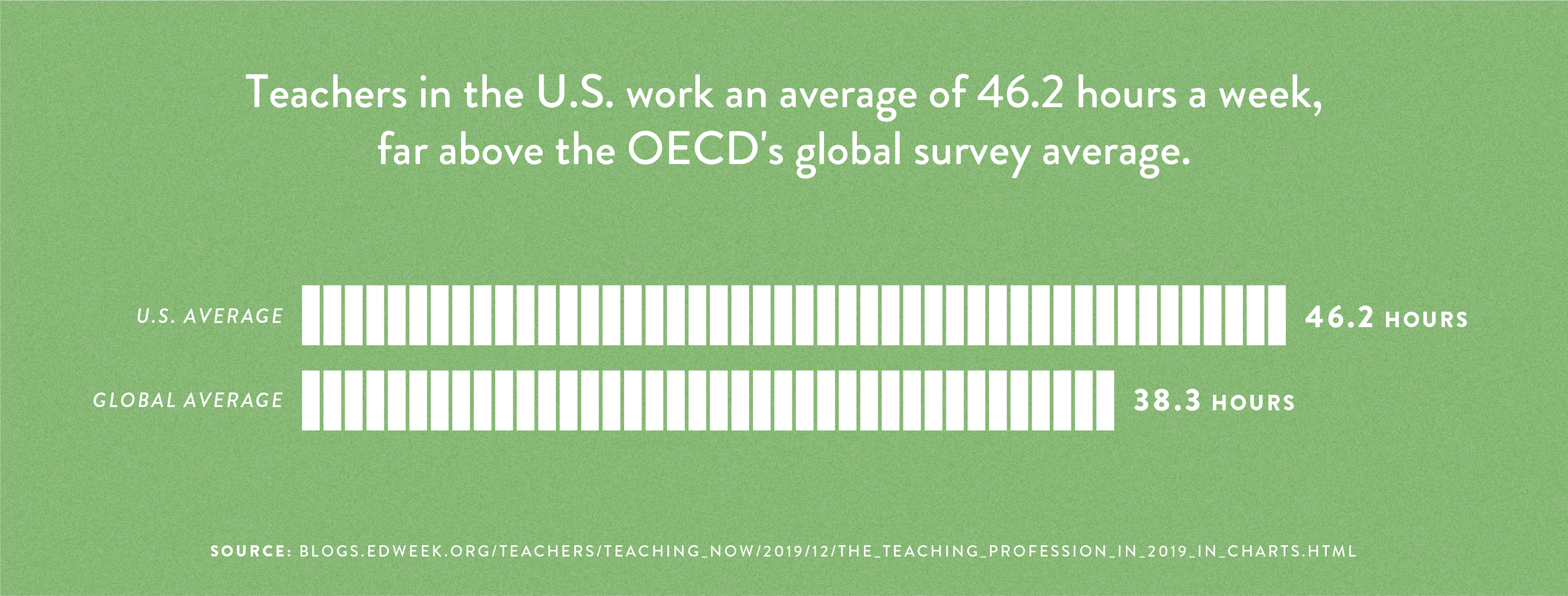
A 2019 Project Team co-led by The Ingenuity Center at UT Tyler and STEMteachersNYC, with partners from nine other organizations, focused on researching and better understanding innovative approaches to integrating professional growth into the school day, highlighting a number of best practices from around the country that are currently being tested by partners nationwide. Practices include early student release days, collaborative teacher time during student lunch, and a year-round calendar that uses three-week break periods for teacher PD and vacation. 100Kin10 partner New Classrooms is exploring structural changes to their weekly schedules, physical spaces, and priorities around partnerships, each as a means of providing opportunities for increasing teacher collaboration and leadership. We’re looking forward to learning more through a 2020 project team led by STEMteachersNYC and University of North Carolina System that will continue this work by publishing a resource containing innovative scheduling options for job-embedded professional learning.

“Technology is here to stay, and we need to provide our students with learning opportunities to use technology appropriately and responsibly.” Doug Hodum from Mt. Blue HS in Maine 100Kin10 Teacher Forum member
Technology used to mean getting hardware into schools, but as digital tools have proliferated in classrooms, there is increased understanding that students (and teachers!) need to move beyond being consumers of technology. As daily activities at work and in personal life are increasingly driven by tech, students need not only hard and soft skills in technology, but also digital literacy and technological competency.

100Kin10 partners are exploring the frontiers of digital literacy in STEM education, developing a variety of tools and resources to equip teachers with strategies for evolving their use of technology in the classrooms. A 2019 project team led by Public Education & Business Coalition with three other partners is contributing to an ongoing body of work focused on digital literacy as a component of teacher preparation, including powerful new self-assessment tools, while KQED Teach has developed professional learning opportunities for educators to build skills in digital storytelling, data visualization, and critical media literacy. PhET Interactive Simulations at the University of Colorado Boulder is working to develop new resources and approaches for pedagogical training around teaching with technology, and Project Tomorrow is developing a new professional learning model to help teachers infuse computer science and computational thinking into their instruction. 100Kin10 ally ISTE is leading a campaign for teaching digital citizenship and provides teacher resources around technology in education.

We’ve known addressing the STEM-specific needs of rural schools has been critical for years: STEM teachers in rural communities often feel isolated and lack opportunities to connect with peers and access professional learning. Our Grand Challenges research led us to understand that strong work environments that make time for collaboration and professional growth play a disproportionately pivotal role in sparking catalytic change. We’re excited to see a number of 100Kin10 partners building on this understanding and applying it specifically to rural schools through research, experimentation, and project teams.

In 2019, the University of North Carolina and the North Carolina School of Science and Mathematics developed and shared strategies for supporting teachers at rural schools by providing them with STEM lessons, best practices, and a community with which to support and share ideas. The University of Colorado Colorado Springs led a Project Team to explore existing research on a variety of STEM activities and to identify who is successfully supporting STEM teachers in rural communities, while the National Math and Science Initiative is working on a state-wide ecosystem in North Dakota to connect geographically and economically isolated communities, including reservation schools. And in 2020, we’re excited to see even more ideas, strategies, and programs emerging around rural STEM from multiple 100Kin10 Project Teams that are focusing on this work.
The Maine Mathematics and Science Alliance will be working to develop partnerships between at least 50 STEM experts and teachers in rural communities to learn about each other’s work and identify STEM learning experiences, while a 2020 Project Team led by Gulf of Maine Research Institute will be exploring how to best support teacher collaboration in rural areas by creating a case studies of best practices. We predict more action on the experience of working in rural schools for our rural STEM teachers, especially as attrition risks grow and schools, districts, and states understand the importance of retention.

There’s a groundswell of interest and efforts to bring computer science into K-12 classrooms. In the past four years alone, more than 40 states have responded to this growing interest by passing policies to boost computer science. New York City and Chicago Public Schools – two of the largest districts in the country and both 100Kin10 partners – are working to integrate computer science offerings into all of their schools, while Virginia recently became the first state to mandate computer science education starting in kindergarten. Yet there remains a growing and unmet demand for computer science teachers. According to Carol Fletcher at UT Austin’s WeTeach_CS program, nationwide, pre-service CS preparation is almost non-existent.

In response, 100Kin10 partner WeTeach_CS and other leaders in the field have shifted to focus on helping in-service teachers build their skills and readiness to teach CS. Since September 2015, WeTeach_CS has provided professional development and support to over 500 teachers in Texas who have earned their CS certification, which is greater than the total number of preservice CS teacher graduates across the whole U.S. As other states begin adding a CS teacher certification, WeTeach_CS has expanded to support teachers in obtaining CS certification nationally. Project Tomorrow is developing a new professional learning model to help teachers infuse computer science and computational thinking into existing courses. In order to encourage other innovative approaches, CSforALL launched their EcoSysytemsforCS initiative that provides catalyst grants to 10 communities across the US to promote community-led systems change in K-12 computer science education, and the Digital Harbor Foundation will support districts in identifying and evaluating high-quality technology and computer science curriculum that build teachers’ capacity in CS. We expect to see even more activity around CS teaching (and teachers!) in 2020.

This year, we’ve seen STEM continue to expand into early childhood education, and we believe this trend will accelerate in 2020. Experts suggest that exposure to STEM during early childhood is critical to long-term student educational outcomes and that science instruction in particular improves abilities in subjects outside of STEM, including literacy, language-learning, and executive functioning. We’ve seen exciting projects emerge from 100Kin10 partners. Bank Street College of Education and the New York Hall of Science are developing Early Childhood STEM educators through a collaboratively taught STEM graduate school course, designed for K-2nd grade teachers. Similarly, the American Museum of Natural History is working to enhance early STEM education through active STEM learning experiences designed for PreK-1st grade teachers, and Loyola Marymount University School of Education, is partnering with Auburn University and the California Science Center to develop age-appropriate kindergarten STEM instructional materials. Meanwhile, AdvanceEd is piloting a new early-childhood STEM teacher certification and organizations outside of the 100Kin10 network, like Frost Science, the University of Miami and the Institute for Education Sciences are teamed up to develop a comprehensive early childhood science curriculum called ECHOS. And we’re especially excited to see what emerges from four project teams with a total of 34 members that are collaborating throughout the first half of 2020 to tackle specific elements of foundational math, growing from 100Kin10’s focus on the highest-leverage catalysts in elementary STEM learning.

Partner funders have been leading this charge for years, in particular around math. The Heising-Simons Foundation is funding early math programs, with a focus on equity, while The CME Group Foundation has provided grants to organizations in the early childhood education space to support strengthening math education. All this activity leads us to believe we’ll see more projects, visibility, and progress around STEM in early childhood education in 2020. And while it’s fantastic that STEM is becoming increasingly valued in ECE, the risk remains that this shift will only increase inequities between high and low-poverty schools, so as we strive to support this progress we must keep our eyes on ensuring equity.

There is growing interest and activism on the part of students worldwide to address the pressing environmental challenges that our planet faces. Young people are taking the lead, calling for future-looking policies and investments that preserve the environment. Greta Thunberg, the Swedish teenage environmental activist, has been one of the most prominent examples, most recently sparking a series of international student climate strikes and protests. In 2019 we saw teachers, schools, and institutions begin to respond to these growing interests, with 100Kin10 partners leading the way.

NOAA and its partners are working to advance climate change literacy by providing teachers with scientific data and educational products that can be integrated into course materials, while The New York Botanical Garden provides authentic outdoor science education to students and teacher programs to enhance children’s understanding of ecology, plant science, and the fragility of the world around them. Other 100Kin10 partners like The Gulf of Maine Research Institute, The Lawrence Hall of Science, and San Diego Zoo Global are all working on developing innovative STEM education programs and initiatives that engage students in environmental awareness and literacy, citizen science, and real-world problem solving, while The Maritime Aquarium and The Lawrence Hall of Science are focused on initiatives to support STEM teachers through intensive professional development in climate science and coastal resilience, and are building the capacity of STEM teachers and school district/charter school leaders for supporting environmental literacy and climate and data literacy throughout the school day, respectively. The New York City Department of Education permitted all students to participate in the climate strikes. We predict that we’ll continue to see a rise in environmental literacy as a theme in STEM education and a driving force in raising the importance of STEM education for the future of our planet.

Research shows that students engage and learn more when the learning is relevant to their lives and interests. As a result, we predict that teachers will continue evolving their roles to provide more personally relevant educational experiences for their students and will do that in no small part as master curators of learning opportunities in and out of the classroom. This might mean that teachers coordinate lesson plans and develop relationships with diverse STEM- and career-relevant partners to create engaging and relevant learning opportunities. To that end, we’ve seen a renewed interest in career and technical education as a means to help students connect the dots between classroom learning and future career opportunities.
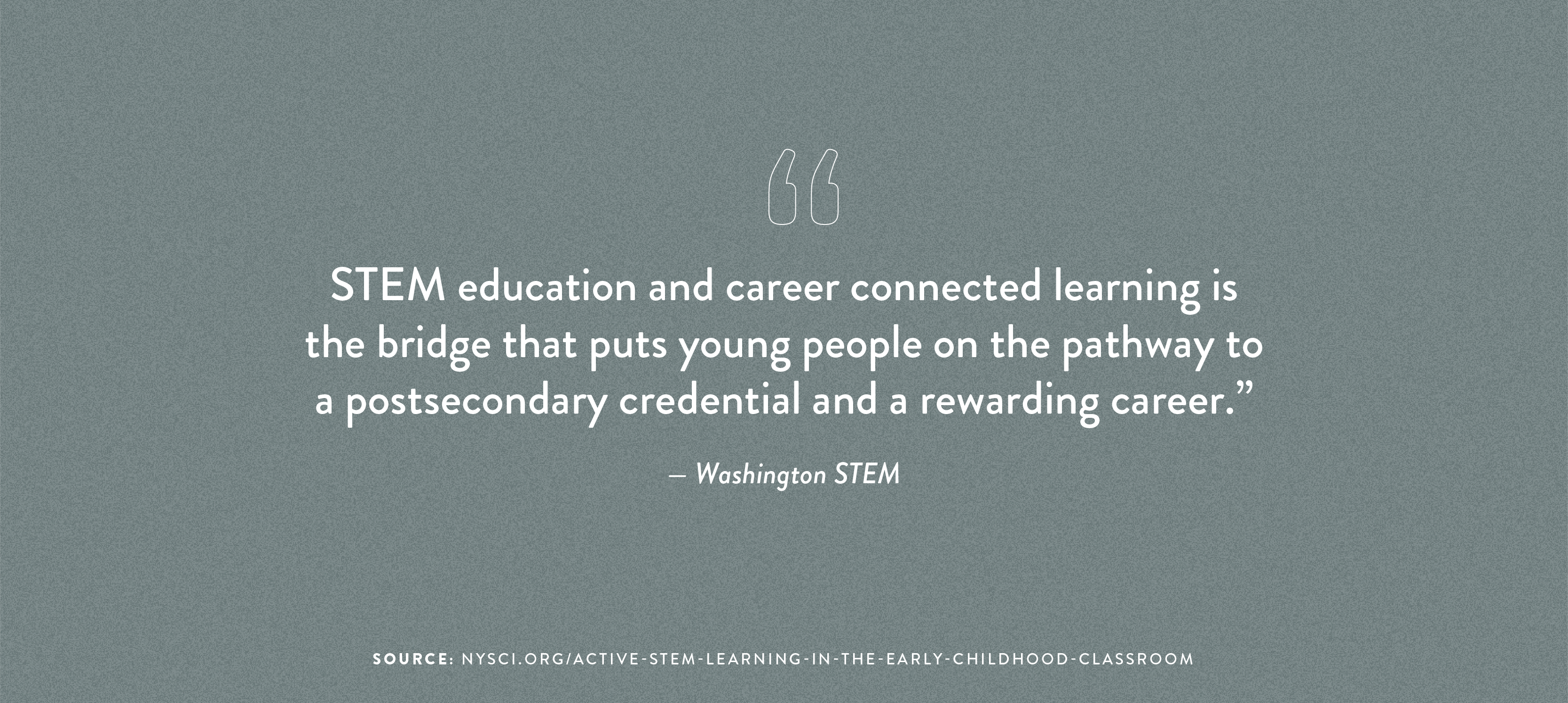
We’ve been inspired to see a handful of 100Kin10 partners already developing innovative practices in this space, like Guilford County Schools – Alternative Certification Track (GCS-ACT) in North Carolina working to engage STEM professionals as partners with classroom teachers to deliver real-world STEM lessons, Washington STEM coordinating cross-sector collaboration between STEM industry leaders and local communities to provide equitable access to career connected learning experiences in STEM, while building and strengthening partnerships. The Orchard Foundation’s Workplace Experience Exchange Program, which matches practicing STEM teachers with regional STEM leaders in industry and academia for professional development. We’ve also heard from 100Kin10 partners across the country that there are increasing demands on teachers to become educational curators, and we’re keeping our eyes on this because we know that STEM subjects are particularly ripe for fostering this type of relevant and engaged learning. We expect to see more STEM teachers leading the way in 2020.

We are continuing to see the rising need, across all disciplines and sectors, for students to gain real-world skills and applied learning while in school in order to be successful in work and life. In response, we’re seeing STEM education leaders increasingly focus on applied-learning pedagogy that centers on real-world interdisciplinary problems and on transforming career and technical education to be more relevant to the 2030 workforce.

We’re already seeing 100Kin10 partners leading the way on these efforts, like High Tech High’s network of charter schools, which focus on authentic work, using projects that incorporate inquiry across multiple disciplines through fieldwork, community service, internships, and consultation with outside experts. Washington STEM is partnering educators with business leaders to develop a coordinated approach to link K-12 students with STEM careers. We also know a few exciting projects just getting off the ground, like Small World Initiative’s work to design, pilot, and share online a set of active learning trainings for STEM teachers. We’re betting that in 2020 we’ll see even more activity in this space, and we’ll increasingly see STEM education being recognized and valued for the tremendous potential it has around applied learning and real-world problem solving that can feed directly into job and life readiness. In fact, 100Kin10 will be contributing to this up-tick in action as we mobilize the network to tackle another of the catalysts (the highest-leverage challenges causing the persistent STEM teacher shortage): increasing the range and quality of STEM courses in high school, with a focus on equity, relevance, and successful course completion.
